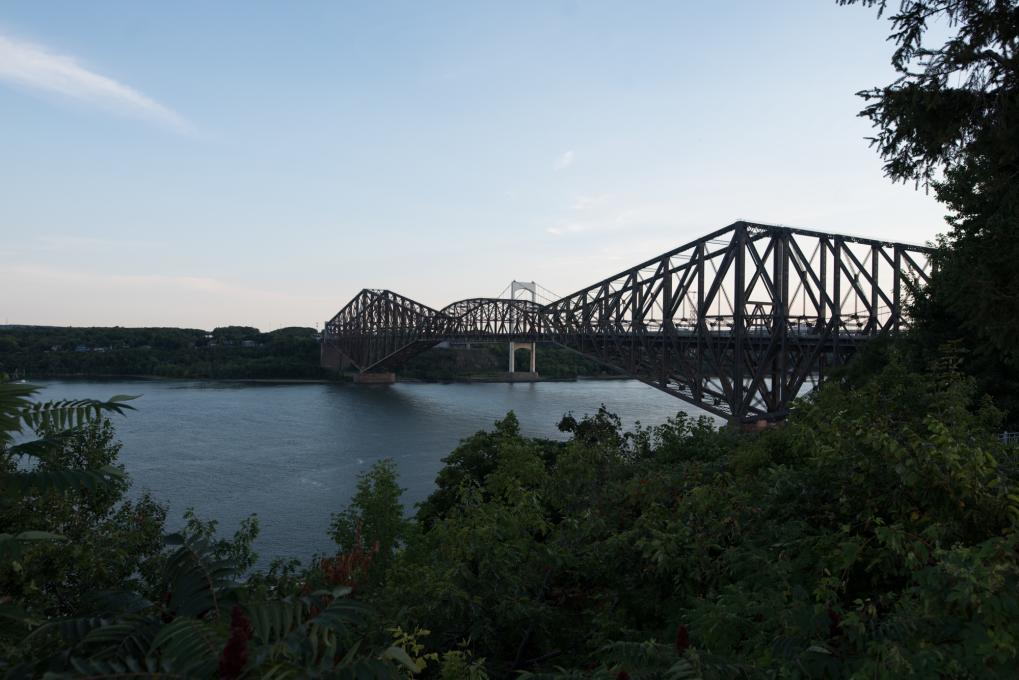The Québec Bridge
Point of interest
A masterpiece of engineering, the Québec Bridge has a suspended span 549 m (1801.2') stretching between the two pylons. It is the longest cantilever bridge in the world, exceeding the Firth of Forth Bridge in Scotland by 27 m (91.9').
The bridge crosses over the St. Lawrence River, connecting Québec City and Lévis. The history of the bridge is marred by it having collapsed twice during construction. It has been designated a national historic site of Canada.
What to do at the Québec Bridge
- Take a picture of the bridge: from the east while standing on the Samuel-De Champlain Promenade or from the west while walking along the sentier Grèves pedestrian trail.
- Cross the bridge to Lévis by bicycle—one of the most beautiful viewpoints of Québec City and the Château Frontenac can be had while riding along the parcours des Anses bike path. It is recommended you take the ferry back to Québec City.
History of the Québec Bridge and its Collapses
In the mid-nineteenth century, Québec City still did not have a railway line connecting it to the south shore. Goods and passengers had to cross the St. Lawrence by ferry or, in the winter, use the ice bridge. In 1887, the site of the future bridge was chosen. Construction was entrusted to the Phoenix Bridge Company, under the direction of Theodore Cooper, an American engineer whose accomplishments included the Second Avenue Bridge in New York City.
While the bridge was being built, workmen were having trouble aligning parts of the structure and noticed that several chords had started to bend. From his New York City office, Theodore Cooper sought to assuage all concerns and confirmed his calculations were correct.
At 5:37 p.m. on August 29, 1907, a terrible clamour was heard kilometres around as the southern portion of the bridge collapsed onto the bank and into the river itself, resulting in the death of 75 workmen. A few months later, it was proven that Cooper had committed basic errors when he had modified his original plans without reviewing his calculations.
In 1908, the Canadian government took control of the project. Under the supervision of a Board of Engineers, rigorous norms were adopted. The original design was improved by developing the new K system of web bracing, deemed sturdier, more elegant and easier to build.
Nine years after the first bridge collapsed, the central span was raised while a crowd numbering over 100 000 gathered to celebrate the event. Unfortunately, tragedy struck a second time when the central span collapsed again: 13 men died, and another 14 were injured. The cause was determined to be a defective beam.
On September 20, 1917, the new central span was successfully installed before a crowd of people from all over Canada and the United States. The two train tracks crossing the bridge connect the Québec City region directly with the south shore of the St. Lawrence River, as well as provide a link to the American rail network. This marvel of civil engineering was considered of such international significance that it was officially inaugurated by the Prince of Wales, the future Edward VIII of England, on August 22, 1919. A roadway measuring 4.27 m (14') wide was added in 1927, thus allowing cars and trucks to cross the bridge. In 1948, the government had this roadway expanded and removed one of the railway tracks. Over a hundred years after it was built, the Québec Bridge continues to be referenced in engineering manuals worldwide. It was designated an International Historic Civil Engineering Landmark by the Canadian Society for Civil Engineering and the American Society of Civil Engineers, as well as a national historic site by Heritage Canada.
Pierre-Laporte Bridge
Right beside it stands the Pierre-Laporte Bridge, the longest suspension bridge in Canada open to vehicular traffic. It took four years to build and was completed in 1970. Its deck is attached to two cables measuring over 60 cm (23.6 in) in diameter. Each comprises over 12 500 steel wires which, if placed end to end, would circle three-quarters of the way around the Earth.










